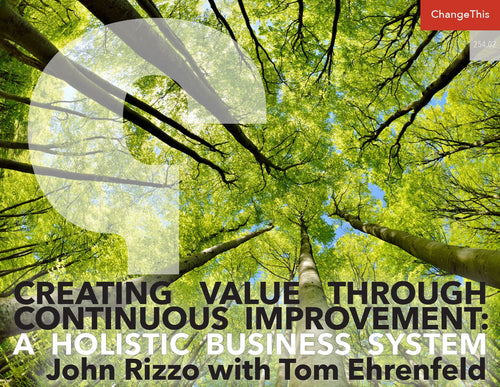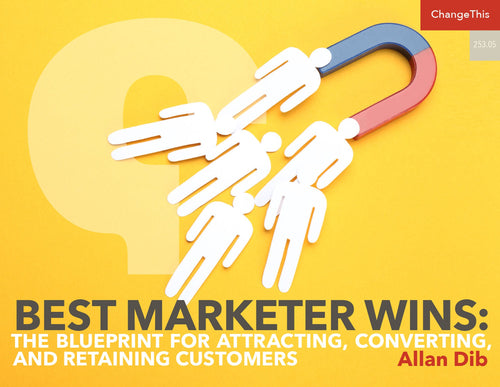Making Honest Conversations the Norm
Imagine this.
A black box on every airplane that could tell the pilot when the plane was headed for trouble while it was still up in the air. You can bet that box wouldn’t be ignored.
But what if every company had a black box that could tell top management when the company was headed for trouble even while it was still doing fairly well? If you were the CEO, would you listen? Of course, I don’t know you personally, but I do know that every company already has such a black box and that very few use it.
SILENCE IN THE COCKPIT
Companies get into a lot of trouble that could have been avoided. Many companies described in influential books such as Built to Last and Good to Great are no longer high-performers and the cultural values of their founders have dissipated.
Hewlett-Packard, so admired for its first five decades, is no longer the high-commitment, high-performance company it was. Companies that have “blown it” spectacularly in recent years include Wells Fargo, Boeing, General Electric, British Petroleum, Johnson & Johnson, Nokia, and Volkswagen. Poor strategy, ineffective top leadership, bad culture, unethical behavior, low morale, rapidly changing technology, inadequate structure, poor customer service, high prices, and a rapidly changing industry all played their parts, but the root condition that allowed these threats to be so damaging was organizational silence.
Lower-level people knew about the competitive and ethical threats long before the crises hit. They often knew, well before top management, about silent barriers that undermined effectiveness, performance, and employee and customer loyalty. But they had no way to speak truth to power, at least not in any way that was safe, yet would impel top management to action.
However, this plague of organizational silence is something that can be changed.
THE BLACK BOX: HONEST CONVERSATION
Thirty years ago, I began helping companies conduct what I now call honest, collective, and public conversations as an antidote to organizational silence. In brief—I’ll explain in more detail below—honest, collective, and public conversation can be implemented through a formal process which I first developed for Becton Dickinson’s CEO Ray Gilmartin and which has since been used by four of his successor CEOs there and by hundreds of other organizations. It enables employees to provide valid and compelling feedback to top management about the good, bad, and sometimes ugly facts of the company’s effectiveness in a way that doesn’t get them in trouble and that does impel top management to take action.
“This plague of organizational silence is something that can be changed.”
It is honest because it brings out the unvarnished truth; collective because it involves key lower-level people not only in gathering the unvarnished truth, but also in collaborating with management to reshape strategy, policy, and practices; and public because the fact that it is taking place, its purpose and format, and—most importantly—the results are all made known to the whole organization.
HOW IS THIS EVEN POSSIBLE?
There are certainly reasons why honest conversation seems like wishful thinking. As experience tells us and as numerous studies confirm, it’s hard to tell senior management about something that’s going wrong—operationally or ethically—for fear of being sidelined or tagged a poor team player. Those who do try seldom hear what changes are (occasionally) made as a result. This leads to dangerous cynicism, as employees come to believe their company cannot change. More importantly, the power differential fools top leaders into thinking that they do not need help from below. Consider one CEO’s response: “What do you mean by partnership with employees? Leaders decide.” Well, they do. But they can decide with or without the crucial insights that can only come from below. A pilot makes the decisions in the cockpit, but it’s a very dangerous pilot who won’t consult his instruments or lower status co-pilot. This same dangerous self-reliance can be found in too many organizations of all types.
Most organizational transformations crash in large part because they are top-down. Some get nowhere—recommendations for change are made and then ignored. Other transformations lead to unintended consequences, but management doesn’t know this until a crisis hits. Consequently, most fail to accomplish their stated goals or else do so far too slowly.
The formal process of honest conversation, however, is specifically designed to overcome these obstacles. One form, which my colleagues and I have developed over the last 30 years, is called the Strategic Fitness Process (SFP). Very briefly, these are the steps:
- Top management creates a concise and concrete formulation of the new strategy and cultural values it wants to adopt. It also announces to the whole company that it is embarking on a formal process of honest conversation and explains how that will work.
- Top management chooses a task force of about eight well-regarded, widely trusted leaders below the top-management level.
- The task force interviews about 100 people. Most are key employees in all the units and functions, but they can also be external stakeholders. These interviews are not a general opportunity to vent. They focus on two specific questions. First, which company strengths must be preserved in order to carry out the new strategy? Second, what barriers within the company will undermine that strategy?
- The task force presents its findings—the unvarnished truth—to top management. This is an intense, face-to-face gathering, not a written report.
- Top management meets to formulate a strategy that addresses the task force’s findings. The task force is told about the resulting plan for change but may disagree, in which case there is some back-and-forth. Management is not compelled to act on everything they learn but must explain why if they don’t.
- The final action plan for change is presented to the organization as a whole.
As I said, this process is specifically designed to overcome people’s natural reluctance to speak truth to power and top management’s all too human natural reluctance to acknowledge its own failures.
Note that top management hears what’s wrong from the very people—the task force—whom it chose for their competence and trustworthiness. The task force is encouraged to quote directly what it heard (while preserving the anonymity of those who said it), which not only lends authenticity to the feedback but also conveys the passion with which many employees really want their company to succeed. This passion often comes as something of a surprise to top management and is very energizing. Because ad hominem or vicious attacks are not allowed, top management hears what it needs to hear without having the conversation bog down in defensiveness and anger. Of course, people do feel defensive and angry, but the process’s carefully designed structure and guidelines prevent such feelings from taking control. All told, the process temporarily suspends some of the effects of hierarchy and makes it possible to speak truth to power. The information reported is perceived as valid and compelling.
Note, too, that top management commits itself from the start to an open process. Everyone knows that the honest conversation is taking place and is therefore waiting to see the results. Many key people come to know exactly what top management was told, however unflattering some of it was. If top management ignores what it has heard, it will have openly betrayed the task force members—by design, some of the company’s most valuable employees—who promised their interviewees that their insights would be taken seriously. Furthermore, once top management and the task force agree on changes in how business is organized, managed and led, that plan is made public. If top management doesn’t follow through, the whole company can see that.
“All told, the process temporarily suspends some of the effects of hierarchy and makes it possible to speak truth to power. The information reported is perceived as valid and compelling.”
Clearly, such a process makes top management vulnerable. But the most successful leaders of honest conversations turn that very vulnerability into a strength. A great example is Lynne Camp. As vice president and general manager of Agilent Technologies’ Systems Generation and Delivery Unit (SGDU), she had been charged with creating a single global company from a fragmented set of businesses. She had a plan, but it wasn’t working. Implementing centralizing decision-making had provided control, but it slowed decisions, prevented focus on five businesses strategies and created conflict with the field organization. Consequently, Camp was perceived as ineffective and lost credibility.
Camp undertook an honest conversation, using the Strategic Fitness Process. Though she was generally well liked, there was some very damning feedback about her leadership.
I took personal responsibility. I stood up and unhooked my name badge and put it on the table, saying, “It’s clear that this isn’t working. It’s also not clear whether I am the right leader to lead this organization going forward.” I told them I was committed to spending the week trying to get to a solution to address these issues. At the end of the week, if I am not the right leader, I will step down…My staff then each unpinned their name badges and put them on the table. We were all pretty touched by how bad it was and that we were responsible.
The mutual commitment grounded in that experience of shared vulnerability had much to do with SGDU’s subsequent success.
Thirty years of hands-on experience confirms that honest conversation works. Studies of 100s of implementations of SFP found that when leaders follow the process and its underlying principles, it surfaces the whole truth about barriers to learning, change, effectiveness, and performance. These results are a function of the systemic diagnosis and changes made and the trust, partnership, and commitment built by the SFP. This is why I feel confident that honest conversation is the black box that can squawk the necessary warnings into the cockpit in such a way that the pilot can avoid disaster.
“Most organizational transformations crash in large part because they are top-down.”
A task force at Hewlett-Packard’s Santa Rosa Systems Division (SRSD) reported, for example, the following barriers:
- SRSD had “two competing strategies battling each other for the same resources” and “SRSD is still not sure what kind of business it wants to be.”
- Members of the senior team “operate within their own silos…like fiefdoms that refuse to cooperate effectively for fear of losing power.”
- The division’s leader tended to resolve issues privately with individual managers rather than hash things out with his whole team and arrive at a mutual decision.
- “There is a cold war going on between R&D and the Custom Systems department located within manufacturing.”
- People are frustrated by these barriers, cannot find a way to report them in a safe and productive way task force members reported.
Armed with those insights from below and committed by the honest conversation process itself to acknowledging and addressing them, SRSD in fact made very rapid improvement in its whole system of organizing, managing, and leading and, consequently, in its business outcomes. As a Hewlett-Packard EVP later remarked:
It is the work [SRSD] did on alignment [using the SFP] that got them to come to grips with what business they wanted to go after and what the business model was that was needed…Today I see them as one of our star divisions…Compared to other divisions, it probably is the most dramatic turnaround.
ORGANIZATIONAL TRANSFORMATION NEEDS TO BE SYSTEMIC
Organizations are systems, which means that the various parts affect each other and— as SRSD’s senior team found out—making changes in one part depends on making changes in others. That’s why organizational transformations are so seldom successful.
Honest conversation addresses this problem directly. It brings out a host of problems, but because—at least, with SFP—it is guided by two specific questions, these problems tend to be related in a way that may never have been stated openly before. Put another way, the process brings out the systemic obstacles to the strategy. Leaders may at first feel overwhelmed by all the problems but come to see that they are all related, making them much more solvable.
Also, because the process of honest conversation tends to create commitment at all levels, as we saw dramatically with Lynne Camp’s team at Agilent, it becomes feasible to attack the many threads of a systemic problem. Because the process and its results are public, everyone understands why so many things need to be changed and what these changes will add up to.
As many studies have documented, a systemic approach is not only much faster, but also much more effective than trying to solve interrelated problems one at a time. In today’s rapidly changing competitive environment, that can mean the difference between success and defeat.
THE MISSING STRATEGIC LEARNING AND GOVERNANCE PROCESS HAS BEEN FOUND
The problems that beset companies—both internal and external—never let up. Thus, no transformation can be permanent. For one thing, the pressure that creates organizational silence—the plain fact of a power structure—is always at work. Honest conversation does not grant permanent immunity; the company needs to keep taking its booster shots.
This can be seen in the experience of Becton Dickinson (BD), a global medical technology firm. Staring in 1990 with Ray Gilmartin’s first use of the Strategic Fitness Process, there have been five CEO led company-wide honest, collective, public conversations, as well as many at the unit level. In 2000, brand-new CEO Ed Ludwig used the SFP to help BD face a crisis in performance and a plummeting stock price and to gain commitment from key leaders to radical and painful changes.
In 2010, Ludwig and his designated successor, Vince Forlenza, decided that BD again needed a new strategic direction. With customers increasingly demanding custom solutions rather than BD’s fixed product line, BD had to transform itself into a much more innovative company. Ludwig and Forlenza led a company-wide honest conversation in order to develop genuine commitment to a change in the company’s whole culture.
The results were excellent. Between 2011 and 2016, BD’s percent of sales attributable to new products grew from 8 to 16 percent, revenues rose by 26 percent and stock price by 39 percent, and BD consistently outperformed the S&P 500 Index by a large margin. Forlenza summed up his view of the role the honest conversation in achieving these results:
SFP really energized the transformation in multiple dimensions…The changes we made happened because of SFP…I had a lot of these ideas, but…SFP gave key people in the organization a voice. They could have a dialogue with me…and with others. I didn’t have the whole thing scoped out in my head. It was information from SFP that enabled me to refine my thinking.
But by 2018, Forlenza’s, and his soon to be successor Tom Polen became concerned about coordination and the company’s agility. These were problems that had been brought up in the previous honest conversation in 2010 and addressed through a reorganization. But after eight years of growth, BD had doubled in size and become much more complex and these old problems were coming back. So Forlenza and Polen launched an honest, collective, and public conversation. The resulting action plan for change is now underway, though performance goals will be realized more slowly, given BD’s much greater size and complexity.
BD is not the only company that has learned to elevate honest conversation from a onetime intervention to what I call the “missing strategic learning and governance process.”
“A systemic approach is not only much faster, but also much more effective than trying to solve interrelated problems one at a time.”
What I mean by that is that, just as quality management allows for continuous improvement of technical processes, institutionalized honest conversation allows for continuous improvement in administrative, allocative, and collaborative decision-making processes. SRSD, for example, carried out an SFP every year for five years. As one executive acknowledged:
The first time, we knew very clearly that there were things that needed to get done because…the strains and tensions were almost palpable. Well, this time the issues and tensions were much less apparent—comparatively. But even so, in this second SFP, we dug into the complexities of the system like we had never done before and really understood how different organizational levers affected the processes and culture.
That second SFP enabled a focus on the problem of order fulfillment, which had been brought up by the first SFP. At that time, SRSD had bigger problems to solve first: an ineffective senior team and inter-function conflict. But the second SFP made clear that order fulfillment was still undermining their strategy. That new honest conversation led to a much improved process.
MAKING HONEST CONVERSATION THE NORM
Much-admired companies needlessly sacrifice their competitive advantage. Some make huge ethical blunders. Shareholders suffer huge losses in value while employees, customers and society lose trust and confidence in the institution. Why wouldn’t we want to change this? It’s time for honest conversations that enable employees to speak truth to power to go from being fairly unusual to being the norm in organizations. It’s time to listen—and keep listening—to the black box that’s always been there. This will require boards to insist on the institutionalization of a strategic learning and governance system such as the Strategic Fitness Process. It will require CE0s to use honest conversation and to encourage their unit and function leaders to use it.
CONCLUSION
Thirty years of experience and research has convinced my colleagues and I that making honest conversation the norm would be a great benefit for companies. Regularly consulting the black box that is there in every organization—its own people’s direct knowledge of “what’s going on” and “what’s going wrong”—would result in longer, smoother flights and fewer crashes. Companies will still compete, and some will lose the competition. But there don’t need to be so many preventable failures, ranging from GM’s 30-year failure to de-bureaucratize and improve performance to Wells Fargo’s failure to put a stop to an obviously out-of-control practice. In all such cases, the black box was full of information—multiple voices saying, “We’re going to crash.” No one in the cockpit turned it on to listen.
Making well-tested methods of honest conversation a norm of corporate management is the way to change this.











































